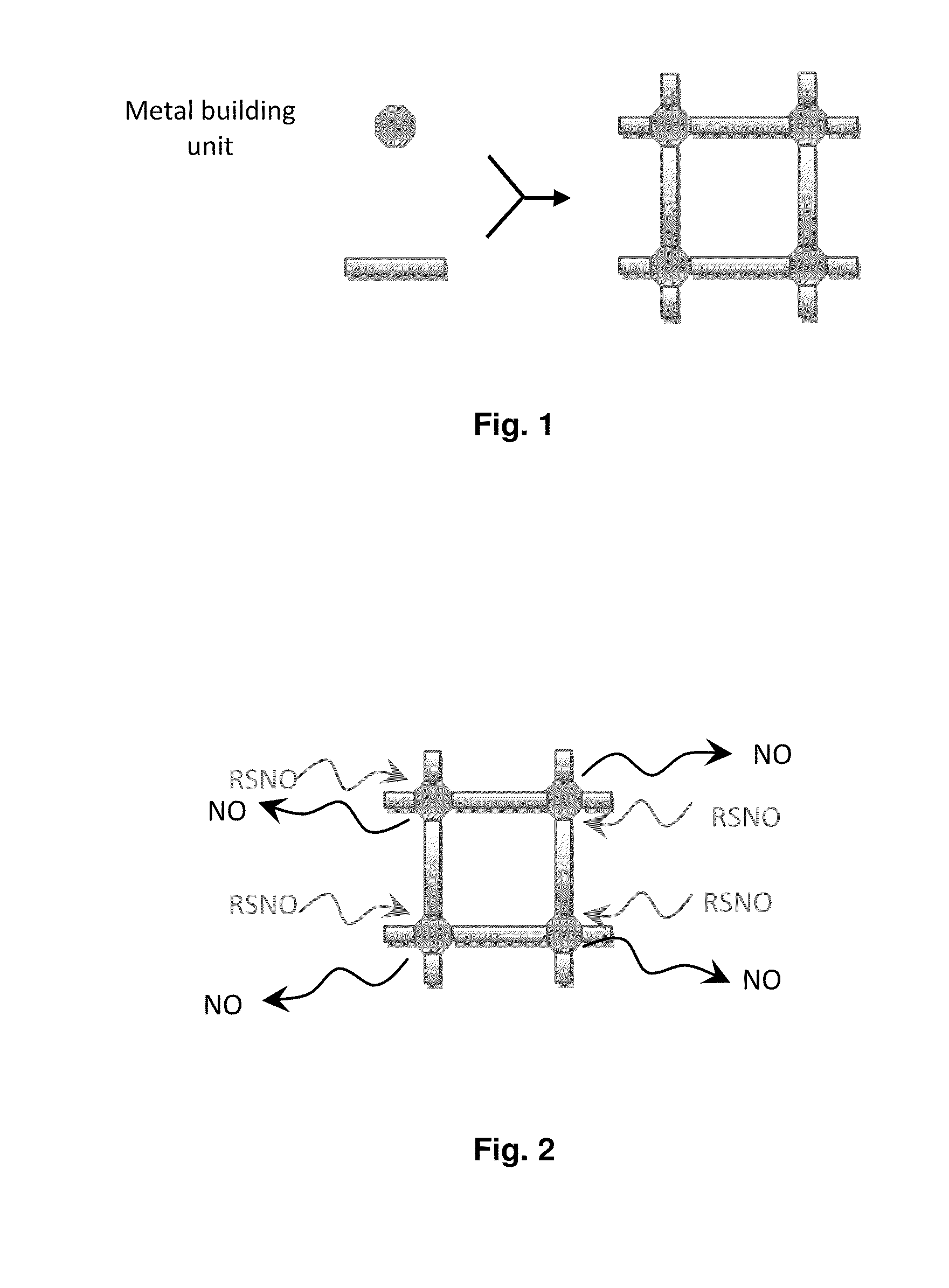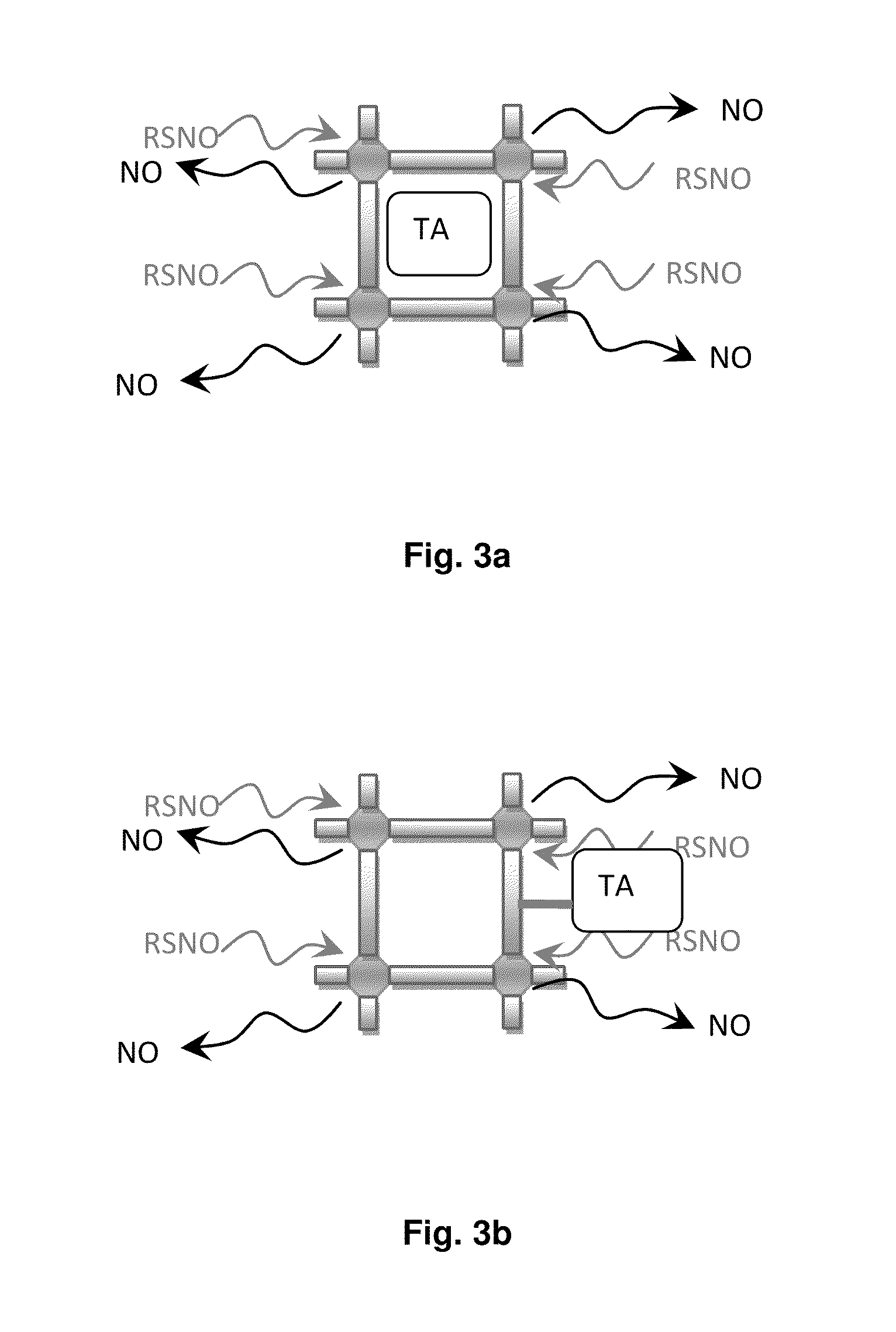Biocompatible materials for medical devices
- Summary
- Abstract
- Description
- Claims
- Application Information
AI Technical Summary
Benefits of technology
Problems solved by technology
Method used
Image
Examples
example 1
Materials and Instruments
[0137]Glutathione (GSH) and bis(2-ethylhexyl) sebacate, 97% were purchased from Acros Organics and used as received. Sodium nitrite, 97%, phosphate buffered saline (PBS) tablets and (ethylene dinitrilo) tetraacetic acid disodium salt, dehydrate (EDTA) were purchased from EMD Chemicals and used as received. High molecular weight poly (vinyl chloride) (PVC) was purchased from Aldrich. Tetrahydrofuran (THF), hydrochloric acid (HCl), acetone, and ethanol were purchased from Fisher and dried over 4 Å molecular sieves before use. Nitrogen and oxygen gases were supplied by Airgas.
[0138]UV-vis spectra were recorded using a Thermo Evolution 300 spectrophotometer. X-ray diffraction data were collected using a Scintag pXRD, equipped with a Cu x-ray source. Nitric oxide release profiles were obtained using a Sievers Nitric Oxide Analyzer (NOA), model 280i.
example 2
Preparation of Cu3(1,3,5-benzenetricarboxylic acid)2
[0139]Cu3(1,3,5-benzenetricarboxylic acid)2 (Cu3(BTC)2) crystals were synthesized according to literature procedures (Chui, S., et al., Science, 283:1149-1150, 1999) as follows. To a solution of Cu(NO3)2.2.5H2O (0.4187 g; 1.8 mmol) in 6 mL deionized water was added 6 mL of an ethanol solution containing 0.2101 g (1.0 mmol) 1,3,5-benzene tricarboxylic acid (BTC). The reaction mixture was then added to a 12 mL Teflon liner in a Parr reaction vessel and heated under solvothermal conditions at 348K for 20 hours. The resulting crystals were filtered from the reaction solution and washed three times with methanol and three times with deionized water. The materials were activated under vacuum at 373K and stored in a dessicator until use.
example 3
Preparation of Films Containing Cu3(BTC)2
[0140]To a solution of plasticized PVC (1 g; 33.3% PVC and 66.7% dioctyl sebacate) in 10 mL of THF was added 5% by weight of Cu3(BTC)2 crystals. The resulting mixture was vortexed until an even and fine blue-colored dispersion was obtained. An aliquot (2 mL) of the dispersion was added to a 20 mL glass beaker, and the solvent was allowed to evaporate to produce a circular film 3 cm in diameter and 0.250 mm thick.
[0141]To determine the stability of Cu3(BTC)2 incorporated in a plasticized PVC film compared to Cu3(BTC)2 powder, X-ray diffraction data of the film and of Cu3(BTC)2 powder were collected using a Scintag pXRD, equipped with a Cu x-ray source. As shown in FIG. 6, Cu3(BTC)2 incorporated in a plasticized PVC film demonstrated similar morphology compared to Cu3(BTC)2 powder. Thus, incorporation Cu3(BTC)2 in a polymer matrix preserved the structural integrity of the Cu3(BTC)2 framework.
[0142]Additional films were prepared according to th...
PUM
| Property | Measurement | Unit |
|---|---|---|
| Time | aaaaa | aaaaa |
| Composition | aaaaa | aaaaa |
| Diameter | aaaaa | aaaaa |
Abstract
Description
Claims
Application Information
 Login to View More
Login to View More - R&D
- Intellectual Property
- Life Sciences
- Materials
- Tech Scout
- Unparalleled Data Quality
- Higher Quality Content
- 60% Fewer Hallucinations
Browse by: Latest US Patents, China's latest patents, Technical Efficacy Thesaurus, Application Domain, Technology Topic, Popular Technical Reports.
© 2025 PatSnap. All rights reserved.Legal|Privacy policy|Modern Slavery Act Transparency Statement|Sitemap|About US| Contact US: help@patsnap.com



